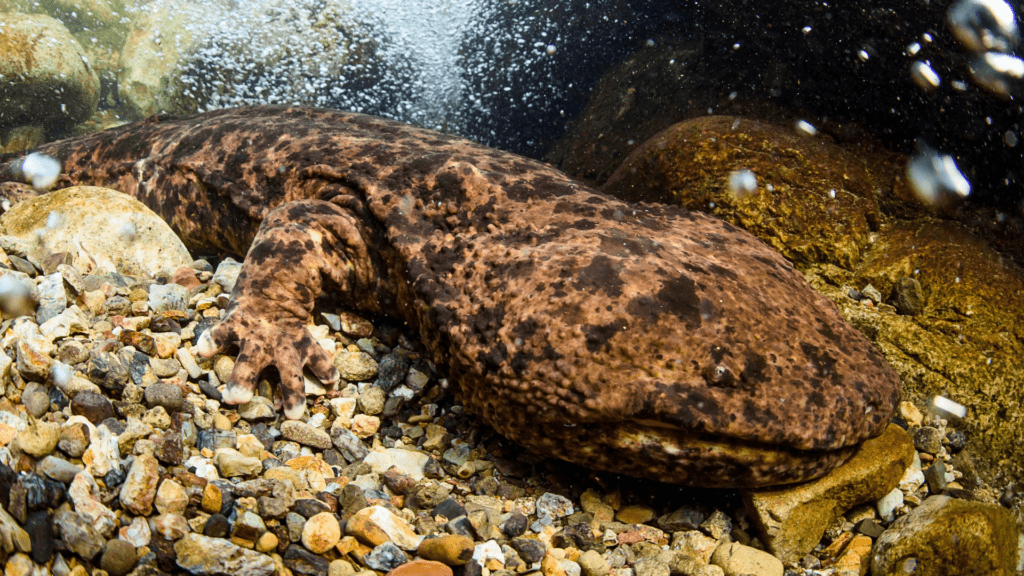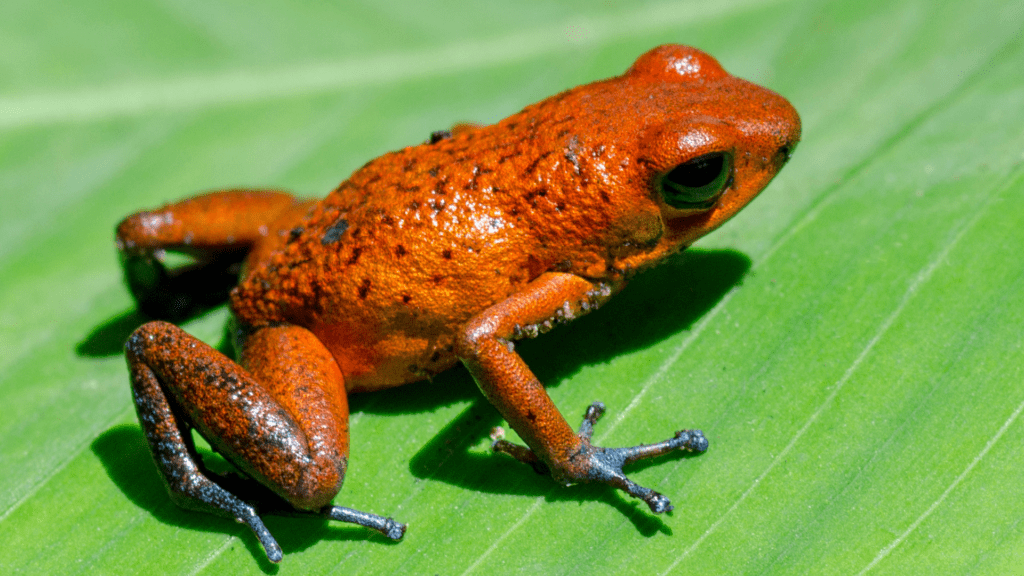Great Crested Newt (Triturus cristatus) is a large, semi-aquatic amphibian native to the United Kingdom and parts of Europe. Recognized for its vibrant colors and distinctive features, it holds the title of the largest among Britain’s three native newt species. However, due to habitat loss and other threats, it is also considered the most endangered newt species in Britain.
Great Crested Newt: Scientific Classification
- Kingdom: Animalia
- Phylum: Chordata
- Class: Amphibia
- Order: Caudata
- Family: Salamandridae
- Genus: Triturus
- Scientific Name: Triturus cristatus
Description
Great Crested Newt stands out with its larger size and unique features compared to other newt species. This species typically reaches 15 to 18 cm in length, with males often being slightly larger than females. The males are especially noted for their vibrant colors during the breeding season, which include a crest that runs along their back.
- Coloration: The body is dark brown or black with a bright orange underside. The sides are dotted with small white spots, giving the newt a distinctive pattern.
- Throat: Their throats are heavily mottled with dark pigments, providing camouflage when needed.
- Toes: The toes of the Great Crested Newt are strikingly marked with black and orange stripes, a feature that is more pronounced in males.
- Tail: The tail is short and ends in a small filament. Females exhibit a yellow-orange stripe along the lower edge of their tails, which further distinguishes them from the males. The tail lacks a sharp pointed tip and has well-developed fins.
Description
Great Crested Newt is a remarkable amphibian known for its size, coloration, and unique physical traits.
- Size: Typically ranges from 15 to 18 cm in length.
- Throat: Heavily mottled with dark pigments.
- Toes: Marked with striking black and orange stripes, more vivid in males.
- Color: Varies between dark brown and black, with a bright orange underside covered in black spots. The sides are speckled with small white dots.
- Skin Texture: Warty, granular texture.
- Tail: Short, with a filament at the end and a yellow-orange stripe along the lower edge in females. The tail has well-developed fins but lacks a sharp pointed tip.
Distribution and Habitat
Great Crested Newt is predominantly found across Britain, Scotland, and Wales, where it thrives in lowland environments. Britain houses some of the largest populations of these newts globally. They are primarily distributed in Northern Europe, from France in the west to the Urals in the east.
Great Crested Newts favor large, shallow ponds on farmlands, where they can find shelter and abundant food. They require undisturbed areas like rough grasslands, scrubs, or woodlands for hibernation and food hunting.
Diet and Feeding Behavior
Great Crested Newts, As carnivores, primarily consume mollusks, leeches, and various other invertebrates. Occasionally, they will feed on the larvae of other species. Their diet also includes algae, protozoa, small worms, and arthropods.
Behavioral Patterns
These newts exhibit some fascinating behavior:
- Great Crested Newt are nocturnal, actively searching for food during the evening.
- Males perform courtship displays to attract females.
- The newts are terrestrial but breed in ponds and pools.
- They are often found hiding under objects like stones or logs during the day.
- Great Crested Newts can migrate between different locations, depending on the season and environmental factors.
Predators
Great Crested Newt Despite their size and toxicity, they are preyed upon by various animals.
- Grass Snakes, Moorhens, and Mallards
- Kingfishers and Herons
- Fish prey on their larvae.
Adaptations for Survival
Great Crested Newt To evade predators and thrive in their environment, they have developed several survival adaptations.
- Swimming prowess: Excellent swimmers, allowing them to escape danger.
- Camouflage: They can blend in with their surroundings and even simulate death by curling around objects.
- Toxicity: Adults secrete a white substance to deter predators.
- Regeneration: These newts can regenerate lost body parts.
- Oxygen absorption: While underwater, they absorb oxygen through their skin, a special adaptive feature.
Mating and Reproduction
Great Crested Newt breed in large, clear ponds with ample vegetation. Their mating season occurs from March to July, with females laying 200 to 300 eggs during this time. The eggs are carefully wrapped in submerged aquatic plants.
- Mating Rituals: Males gather in open water, performing courtship displays to attract females.
- Reproductive Process: Males release germ cells which the female picks up to fertilize her eggs.
Great Crested Newt: Life Cycle and Hibernation
- Egg Development: Eggs hatch in 1.5 to 3 weeks, and young newts resemble tiny adults with gills and fins.
- Hibernation: From October to March, these newts hibernate in mud at the pond’s bottom or under logs and stones.
- Life Span: Typically, they live up to 10 years.
Conservation Status
Great Crested Newt is currently classified as “Least Concern” by the IUCN, indicating that it is not facing an immediate threat of extinction on a global scale. However, the situation is more critical in certain regions, particularly in Britain, where its populations are in decline due to habitat loss, pollution, and the introduction of non-native species. These factors have caused significant pressures on its habitat and overall survival.
In response to these challenges, a range of legal protections have been implemented to safeguard this amphibian’s habitats. In the UK, the species is protected under the Wildlife and Countryside Act, and it is also listed under European directives that aim to conserve biodiversity. These protections ensure that areas where the species breeds or resides are preserved, and activities that may harm its habitat are regulated.
Additionally, ongoing conservation efforts focus on habitat restoration, such as improving the quality of breeding sites and creating wildlife corridors to link fragmented populations. As a result, while the species may not be in immediate danger worldwide, localized efforts are essential to ensure its continued survival and mitigate the effects of human activities on its environment.
Through these legal and conservation measures, the long-term viability of the species can be supported, ensuring that future generations will have the opportunity to observe and study this fascinating amphibian.
Subspecies
Subspecies of the Great Crested Newt
- Danube Great Crested Newt
- Italian Great Crested Newt
- Caucasian Great Crested Newt
- Macedonian Great Crested Newt
Interesting Facts
- Long Lifespan: Some individuals can live up to 27 years, one of the longest-lived amphibians.
- Distinctive Male Features: Males develop a striking jagged crest during the breeding season, making them easily distinguishable from females.
- Voracious Appetite: Known for their insatiable appetite, they feed on insects, worms, tadpoles, and even smaller newts.
- Confusion with the Smooth Newt: Often confused with the Smooth Newt, but the Great Crested Newt is larger, with a jagged crest and distinctive warty skin.
- Metamorphosis and Adaptations: They begin life as aquatic larvae with gills and later develop lungs, allowing them to live both in water and on land.
- Unique Defense Mechanism: When threatened, they secrete a toxic substance from their skin, deterring predators.
- Role in the Ecosystem: These newts are vital predators and prey, helping control insect populations and serving as food for birds and fish.
These fascinating facts highlight the unique characteristics and importance of the Great Crested Newt in its ecosystem.
Great Crested Newt: Conclusion
it is an extraordinary amphibian with unique adaptations that ensure its survival in the wild. While its population is protected, continued conservation efforts are crucial for its preservation, particularly in regions where it is at risk. Through understanding these fascinating creatures, we can contribute to their conservation and ensure they thrive for generations to come.
faq”s
1.What is the scientific name of the Great Crested Newt?
The scientific name is Triturus cristatus.
2. Where can Great Crested Newts be found?
They are native to Europe, ranging from the UK and Scandinavia to parts of Western and Central Europe. They inhabit ponds, lakes, and terrestrial habitats like woodlands and grasslands.
3. What do Great Crested Newts eat?
Great Crested Newts are carnivorous and feed on invertebrates such as mollusks, leeches, worms, insect larvae, and occasionally the eggs or larvae of other amphibians.
4. How do Great Crested Newts reproduce?
During the breeding season (spring), males perform elaborate courtship displays to attract females. Females lay eggs individually on aquatic plants, and the larvae hatch and develop in water.
5. What is unique about the Great Crested Newt’s appearance?
Great Crested Newts have a dark, warty skin with a bright orange or yellow belly with black spots. Males develop a jagged crest along their back and tail during the breeding season.
6. Are Great Crested Newts endangered?
Yes, they are protected under the Habitat Directive in the EU and the Wildlife and Countryside Act in the UK due to habitat loss, pollution, and declining populations.
7. How long do Great Crested Newts live?
Great Crested Newts can live up to 15-25 years in the wild, depending on environmental conditions.
8. What is the role of Great Crested Newts in their ecosystem?
Great Crested Newts important predators of invertebrates and help control pest populations. They also serve as prey for larger animals like birds and fish.
9. Do Great Crested Newts hibernate?
Yes, they hibernate during the winter months, usually under logs, rocks, or in burrows, and rely on stored energy reserves.
10. How can we help conserve Great Crested Newts?
Protecting their habitats (ponds, wetlands, and terrestrial areas), reducing pollution, and creating wildlife-friendly gardens with ponds can help conserve their populations.

